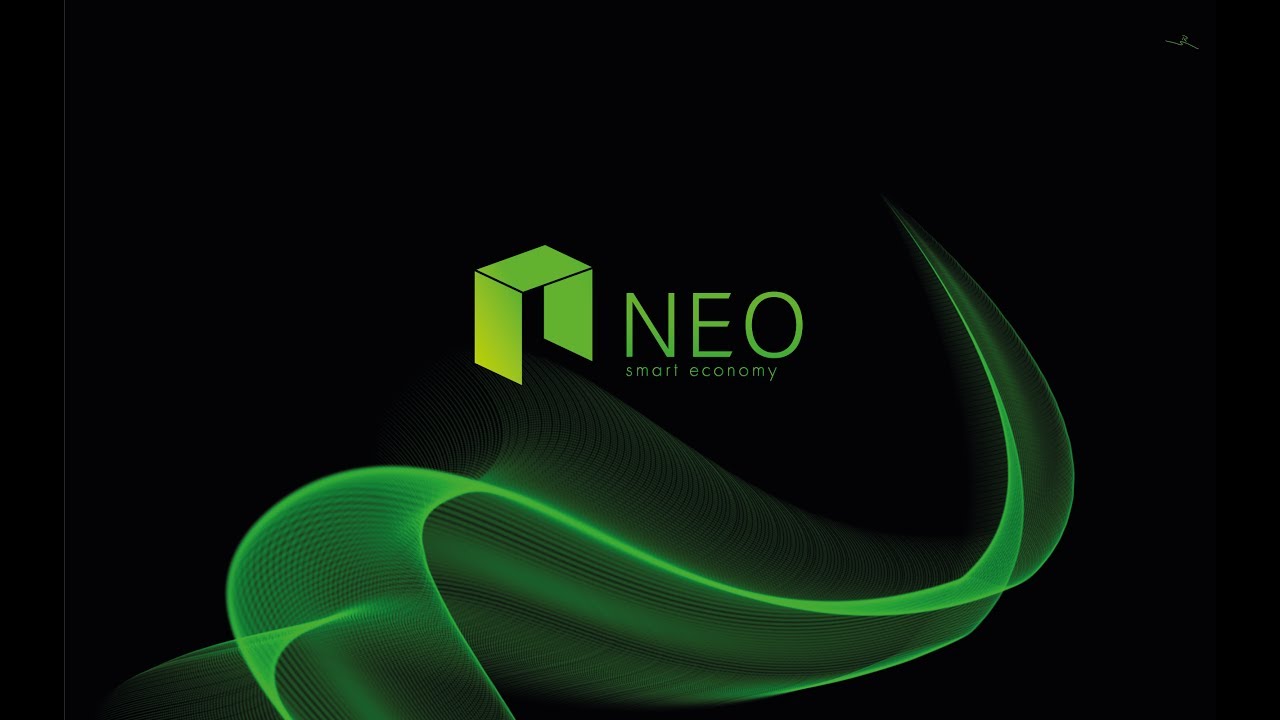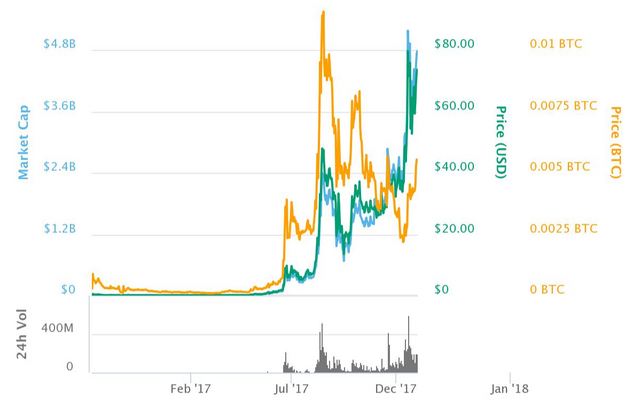The most interesting cryptocurrency to watch out for, in 2018: NEO

Cryptocurrencies have been quite a hot topic, lately. People all over the world have been speculating various cryptocurrencies and by now, it's quite evident that these do in fact solve a lot of problems. By eliminating the taxing intermediaries, enabling fast, safe and reliable transactions and making cheap microtransactions possible, cryptocurrencies have completely disrupted the finance sector.
As 2018 is just about to arrive and many new investors would be keen on investing in cryptocurrencies, I've decided to share my thought on what could be the hottest cryptocurrency in 2018. With bitcoin almost slipping out of the hands of common people with it's outrageous network fees, it's certainly not worth investing if you want to move your money around, in a fast and cheap way. According to me, if you want to earn the most profits, while supporting tech that is practically the most viable solution right now, you must have a look at NEO.
Introduction
According to the NEO whitepaper, NEO is a distributed network for "Smart Economy", which uses blockchain technology and digital identity to digitize assets and uses smart contracts for the digital assets to be self managed. It's quite clear from this statement, that, their aim is to provide you with a digital identity (which we'll talk about later) that you can essentially use as your finger print, and associate that to digital assets that are protected by the network, and, can be used for day to day transactions, without needing to wait for any intermediary to approve your transaction (which makes is almost instant), and, without needing to pay any significant amount (as you would, if you were to transact using normal modes of transfer). Since, the fees you pay for transferring money using conventional methods is already pretty high (and is making the banks richer and the poor poorer), you cannot send a small enough amount, because the fees would be higher than the amount you send. NEO, with it's Proof of Stake algorithm (which will be discussed in the next section), is not only faster than most of the other cryptocurrencies that rely on Proof of Work for achieving a concensus, but is also cheaper, since, you don't have to pay any mining fees. It's also eco-friendly, since, you don't have to expend electricity for this.
NEO's dBFT Proof of Stake
A fault in a system can occur in many ways. One of the most common ways is that the faulty nodes completely stop working. A byzantine fault is a fault in which some of the network's nodes, which are faulty, start behaving in a malicious way and relay different information to different nodes, to stop them from achieving a concensus (i.e. agreeing upon, in this case, the list of legitimate transactions). dBFT stands for Delegated Byzantine Fault tolerance, which seeks to practically make the system immune to such corruption. To understand what it means, we need to take a look at what the Byzantine General Problem is. It goes something like this: Let's suppose that there are a few armies, each lead by a general (who can communicate amongst themselves), who want to attack enemy's army. Some of these generals are traitors. Now, the enemy's army is so large, that the friendly alliance can win only if all the honest generals attack together. However, they can all decide not to attack and defend against the enemy together. In short, the honest generals need to achieve a concensus on what to do. In order to decide what to do, they elect a speaker who decides, whether to attack or to defend. But, since the armies are far away, the speaker needs to send individual messages to each of the other generals, which only the reciever of the message can see. In order to verify that the speaker is not a traitor, the non-speaker generals relay their message to every other non-speaker general. This is essentially the byzantine general problem, wherein, the honest generals need to achieve a concensus, that wins them the war, without knowing which generals are traitors. With mathematical methods, it has been proven that there is no perfect solution to this problem, but, if more than two-thirds of the generals are honest, it is guaranteed that the generals will win the war, if they use a Byzantine Fault Tolerant (BFT) algorithm to achieve concensus. The NEO network uses their own BFT, known as dBFT to achieve the same, wherein, if more than two-thirds of the nodes are legitimate (i.e. don't belong to a hacker), it is 100% guaranteed that the network cannot be hacked and your money is completely safe. Moreover, a PoS enables high speed (instant transfer) and scalability (in this case, currently, 1000 Transactions per second, which can be extended upto 10000 Transactions per second, which surpasses all the current transfer methods by as much as 5 times).
Digital Identity and Digital Assets
NEO seeks to provide its users with a digital identity which is based on Public Key Infrastructure X.509 standard. PKI is the same thing that secures websites (with SSL) and is used for authentication and encrypting messages. Think of it as a highly secure digital thumb impression (or fingerprint). This identity will be used to provide ownership of Digital Assets. These assets are decentralized, trustful, traceable, highly transparent, and free of intermediaries. What this means, is that, your assets won't be destroyed even if a few nodes disappear, as there will be dissected and multiple copies of each piece will be stored across the network (just like creating a backup). This essentially means that no single human being, or even a group, can forcefully acquire your assets or even damage them, if you refuse to obey. Once your assets are on the network, it can be used to gain trust and is also tracable, so that the party with which you're about to transact can be sure that you're not lying and vice versa. Also, nobody can stop you, or charge inexorbitant fees, in case you decided to spend those assets. It is also worth noting that assets registered through a validated digital identity are protected by law.
Smart Contracts
This is something that you might already be familiar with. This term was first proposed by the cryptographer Nick Szabo in 1994, only five years after the creation of the World Wide Web. According to Szabo's definition: When a pre-programmed condition is triggered, the smart contract will execute the corresponding contract terms. Now, there are other cryptocurrecies, like ethereum (which was the first to implement it), that have this feature, but what separates NEO's smart contract is that the existing developers don't need to learn any new language for developing smart contracts.
The languages that are currently supported are:
- C#, VB.Net, F#
- Java, Kotlin
- Python
- C, C++, Golang
- JavaScript
NeoVM virtual machine
Just like ethereum, NEO has it's own Virtual Machine that facilitates running code on top of the blockchain. Unlike ethereum's VM, it's architecture is similar to Java Virtual Machine and .NET runtime, hence, it's able to compile both java and C# (plus related languages) without any problem. It can also be extended further by adding features like Just in Time compiling etc.NeoX atomic swaps
NeoX is NEO's way of providing atomic swaps. In lay man's terms, this means that you'll be able to transact to and from other cryptocurrencies, like bitcoin, ethereum etc. in case your customer doesn't pay in NEO or a retailer doesn't accept NEO, or even if you just want to opt out of it. So, it's completely safe to hold NEO. It's also worth noting that NeoX is an extension of the already existing atomic swap technology.NeoFS filesystem
NeoFS aims at providing a distributed storage protocol for secure and reliable storage of files by using the same idea as previously stated for digital assets. It achieves this by using distributed hash tables. A large file is dissected into pieces and is indexed by the hash that is generated from the contents of a file using a hashing algorithm, instead of just providing it a unique address or path and using that path to locate the file. These pieces are then replicated and stored at muliple locations in the network.NeoQS quantum computing resistance
As you might already be knowing, quantum computers take lesser number of steps to calculate solution to a problem, it is suspected that they might render the existing encryption methods useless. NeoQS is a lattice based cryptographic mechanism which is based on technologies that are currently regarded as the best ways to tackle quantum computers.Future Prospects
 Looking at the price of NEO, you may see that it is yet to see a pump. All the other major cryptocurrencies have recently seen a huge pump. So, it is expected that it will also see a huge pump quite soon enough, from the speculators. Furthermore, being such a refined system, it is expected to grow at a steady pace. Based on my own personal research, it looks very likely that they're going to announce some big partnerships pretty soon (with Microsoft and Alibaba). Discussing this calls for a separate article. Finally, NEO has a sister currency called GAS (which I've not discussed, since the article has already grown pretty huge), which is used for transactions on the network. GAS holds it's own value in the market, but, if you hold your NEO in a wallet like NEON, you get to claim those tokens for free at regular intervals. Who'd not want free money?
Looking at the price of NEO, you may see that it is yet to see a pump. All the other major cryptocurrencies have recently seen a huge pump. So, it is expected that it will also see a huge pump quite soon enough, from the speculators. Furthermore, being such a refined system, it is expected to grow at a steady pace. Based on my own personal research, it looks very likely that they're going to announce some big partnerships pretty soon (with Microsoft and Alibaba). Discussing this calls for a separate article. Finally, NEO has a sister currency called GAS (which I've not discussed, since the article has already grown pretty huge), which is used for transactions on the network. GAS holds it's own value in the market, but, if you hold your NEO in a wallet like NEON, you get to claim those tokens for free at regular intervals. Who'd not want free money?Note: If you reached this point, you probably liked the article. Please give it an upvote to show your support and comment down below on what you’d like to see in the future articles. Suggestions and corrections, if any, are always welcome.
#bitcoin
My head has a headache thinking about the bitcoin price now because its selling it
well technically it saw a rather large "pump" last spring, but who's counting that?
Since u mentioned Neo/Gas, we happen to have a short term spec/rec on it...
https://steemit.com/cryptocurrency/@harpooninvestor/poopcoins-overnite-gas-and-decred
also some longer term recs at the bottom of our article, altho not yet "written up" in detail.
Secondly, your article just calls gas a poopcoin without giving any technical details. Why would anybody believe in your words if you don’t justify them properly?
Thirdly, even if Neo isn’t divisible, it can still be used to pay large amounts and whenever there’s a need for micro transactions or fine tuning a transaction, you can always exchange NEO for GAS, with atomic swaps or even from exchanges. You could also buy GAS directly, if you want transactions. But, for those who are planning on buying huge amounts for holding, NEO does really make much more sense.
I hope you found this article useful